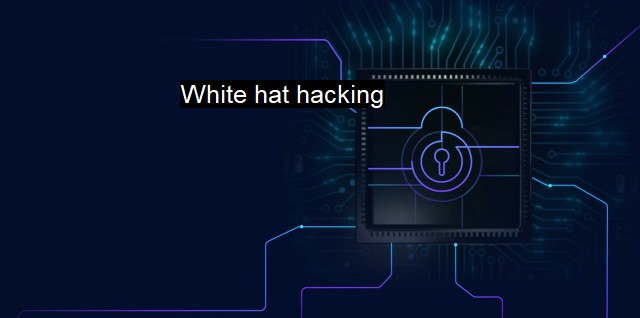What is White hat hacking?
The Significance of White Hat Hacking in Ensuring Cybersecurity and Online Safety: An Ethical Process of Testing the Strength of Computer Systems and Networks to Identify Security Vulnerabilities while Serving as a Valuable Tool for Businesses and Antivirus Industry.
White hat hacking is a key element in the world of cybersecurity. These individuals, often known as ethical hackers, undertake the tremendous responsibility of detecting and fixing vulnerabilities and loopholes in systems before malicious hackers, known as black hat hackers, can exploit them. The motivation behind their effort is to strengthen systems, eliminate vulnerabilities and thus, indirectly ensure the privacy and ensure safety of users worldwide.Fundamentally, white hat hackers possess similar skillsets as their ill-intended counterparts, the black hat hackers. the former holds a distinguishing trait; they operate within the boundaries of committed legal and ethical norms. They utilize their prowess to probe weaknesses, examine their appropriation and fill in the breaches in systems in order to significantly improve security.
The term “white hat” was derived from Western movies, where the positive characters wore white hats. Here, the color signifies purity and goodness. Conversely, the color “black” used in the phrase "black hat hackers" is indicative of malicious intent. Similarly white hat hackers fundamentally contribute to the safety of systems and data integrity, while black hat hackers typically have harmful intentions.
White hat hackers utilise numerous strategies mirroring those used by black hat hackers. Among these, some standard methods include vulnerability assessment, penetration testing, and in some cases, even social engineering methods. Penetration testing, frequently known as 'pen testing', involves the planned exploitation of a system with the prime objective of assessing the system’s potential vulnerabilities. In some scenarios, this may involve being physically present at the location, and in others, it may involve remote probing.
An essential tool in the white hat hacker’s toolkit is the antivirus software. Unlike ordinary users, these ethical hackers delve deeper to understand the complicated workings of such software. They constantly evaluate and assess the detection success rate of these antiviruses, which devote their services to guard systems against possible malware intervention such as spyware, ransomware, Trojans, among others.
Incredibly, some white hat hackers cultivate malware to examine how they could pose potential threats to systems. They do this with a crucial aim, which is to inspect the system’s endurance against formidable fatal strikes and in order to hone up the skills of the antivirus software. This, in turn, plays a massive role in developing more robust systems and powerful antivirus configurations that can detect and avert complex breaches and attacks.
White hat hackers are highly valued in the cybersecurity field. Various businesses employ them, often forming elite ethical hacker teams. Their primary role is to discover and repair vulnerabilities before their exploitation. Thus, employing these hackers presents a forward-thinking strategic approach towards system security against the escalating threat from black hat developers.
Seeking certifications like the Certified Ethical Hacker (CEH) adds credibility and validation to their position as ethical hackers. These professionals abide by rigorous industry standards and not only possess requisite technical aptitude but are governed by intrinsic morals and the cooperation towards making the cyberspace safer.
In sum, white hat hacking is a crucial aspect of cybersecurity, enabling individuals, businesses and governments to secure their invaluable data and systems against the tangible menace of black hat hacking. Engaging white hat hacking practices thus works to continually improve system vulnerabilities and refining antivirus applications. Therefore, the field of ethical hacking will likely continue to be a major player in the emphasizing on cyber threat detection and eradification, poised to take on the ever-evolving landscape of cybersecurity.

White hat hacking FAQs
What is white hat hacking?
White hat hacking refers to ethical hacking techniques employed by cybersecurity professionals to detect security vulnerabilities and loopholes in software, hardware, and network systems. The objective is to identify weaknesses before malicious attacks can exploit them. White hat hackers use their skills and knowledge to improve cybersecurity measures rather than conducting illegal activities.How does white hat hacking differ from black hat hacking?
White hat hacking is carried out with permission and intended to protect assets from malicious attacks. In contrast, black hat hacking is unauthorized and performed with the intention of gaining unauthorized access or causing harm. Black hat hackers use their skills for personal gain and to exploit vulnerabilities for financial or political gain.What are the benefits of hiring a white hat hacker?
Hiring a white hat hacker can help to improve cybersecurity measures by identifying and mitigating existing vulnerabilities. This can help to prevent data breaches, minimize risks, and protect confidential information. Additionally, hiring a white hat hacker can provide insight into the effectiveness of current security measures and help to implement more advanced security protocols.Is white hat hacking legal?
White hat hacking is considered legal when it is done with the permission of the system owner. It is important to obtain written permission before conducting any ethical hacking activities to ensure that all parties involved are aware of the objectives and scope of the testing. Unauthorized hacking is illegal and carries severe penalties, including imprisonment and fines.| | A | | | B | | | C | | | D | | | E | | | F | | | G | | | H | | | I | | | J | | | K | | | L | | | M | |
| | N | | | O | | | P | | | Q | | | R | | | S | | | T | | | U | | | V | | | W | | | X | | | Y | | | Z | |
| | 1 | | | 2 | | | 3 | | | 4 | | | 7 | | | 8 | | |||||||